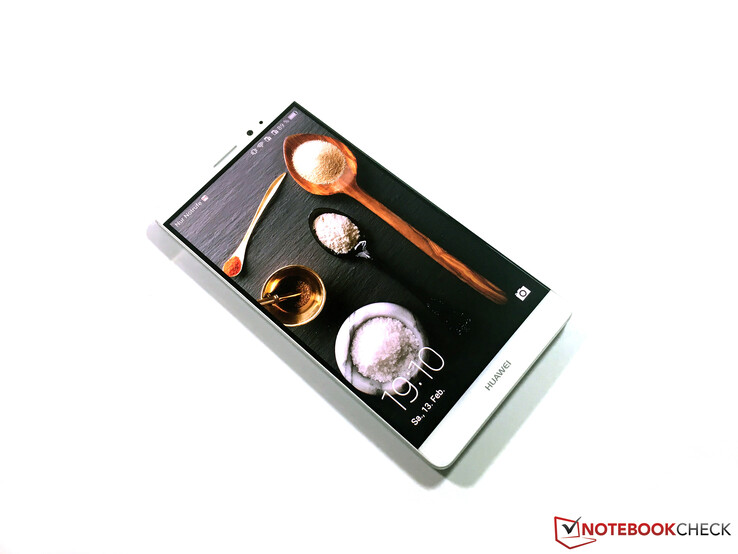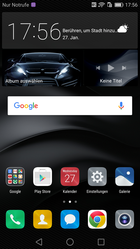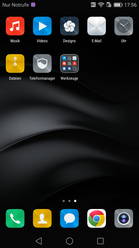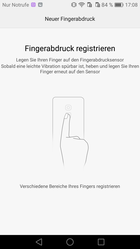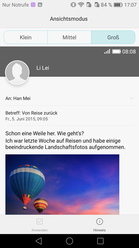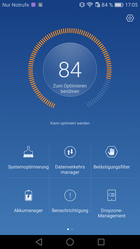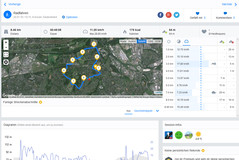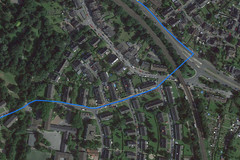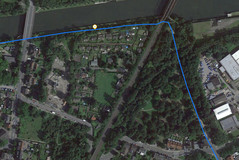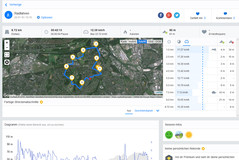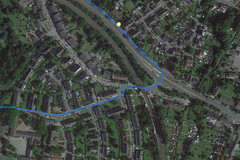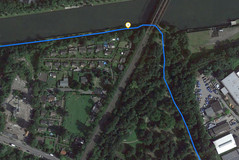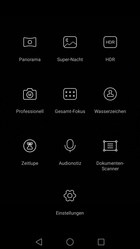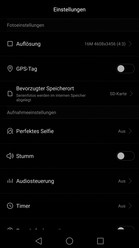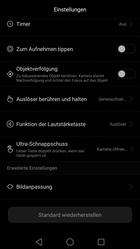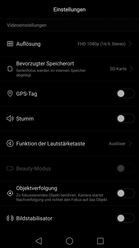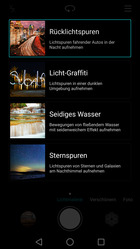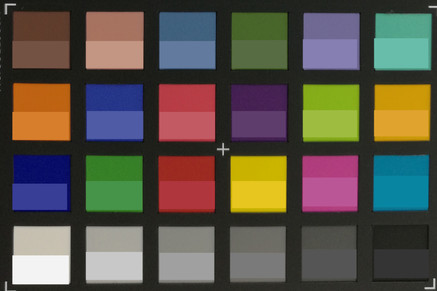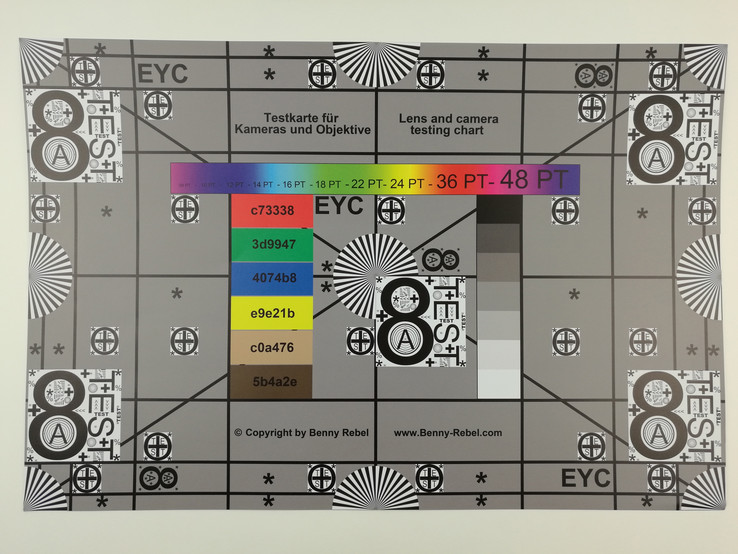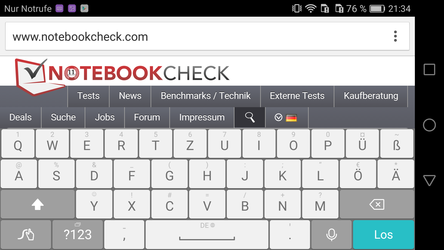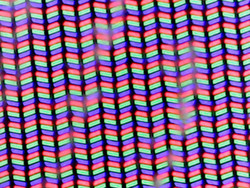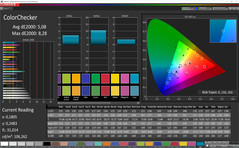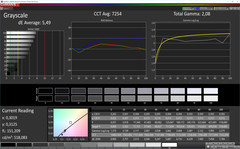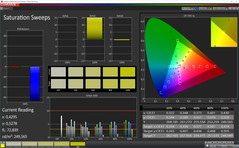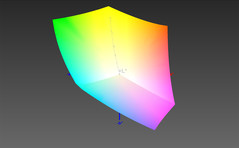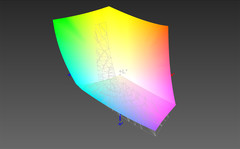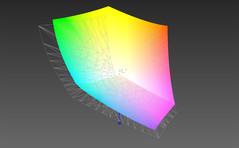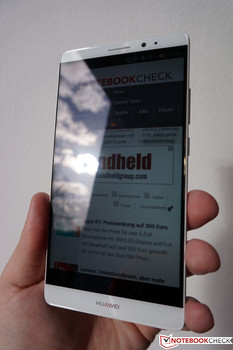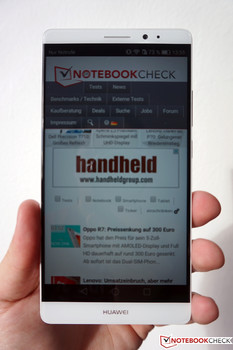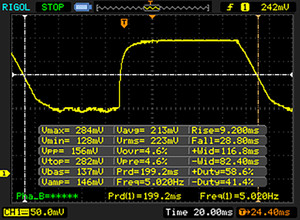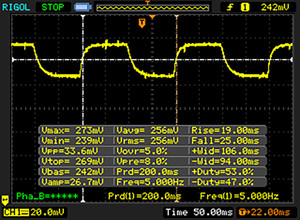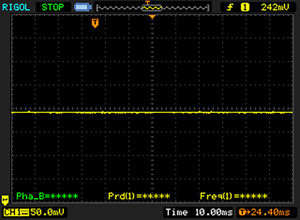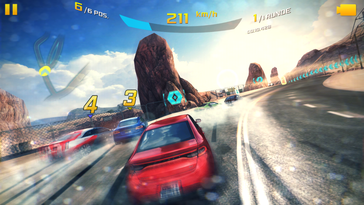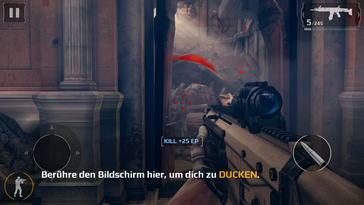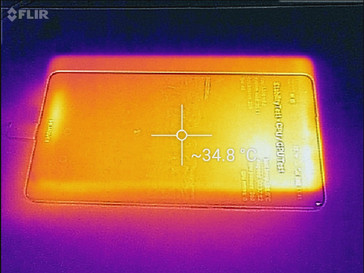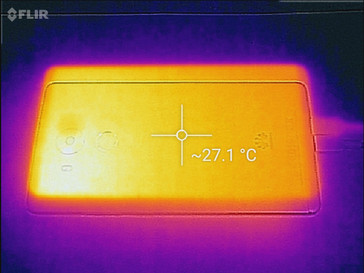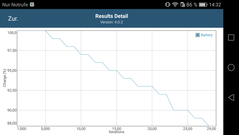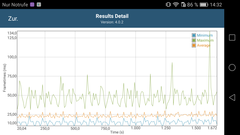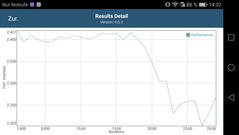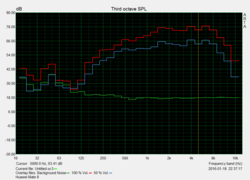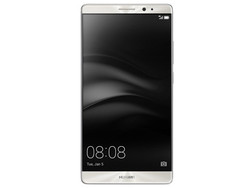Huawei Mate 8 Smartphone Review
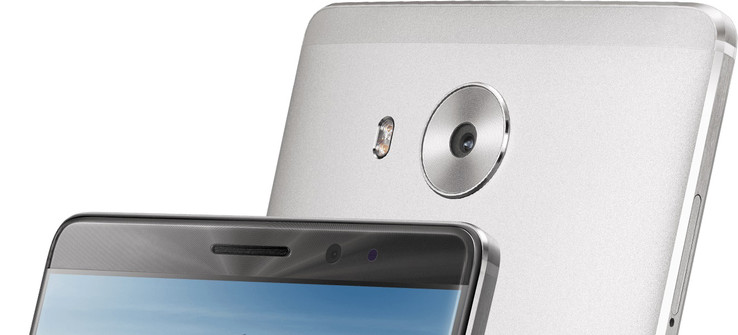
For the original German review, see here.
The Mate 8 from the Chinese manufacturer is the successor to the Ascend Mate 7. Equipped with modern components and priced at 599 Euros (~$667), the Mate 8 is currently Huawei's flagship device, at least until the new P9 is launched. The highlight of the 6-inch smartphone is the Kirin 950 SoC, which already uses ARM's new Cortex-A72 cores. Besides a higher performance, they also promise improved efficiency. You also get 3 GB RAM as well as 32 GB internal storage that can be expanded via microSD-card. At the back is a 16 MP camera with a sensor provided by Sony.
Huawei also reached a high-end price and there are many rivals in this segment. The list includes the Samsung Galaxy S6 Edge+, Google Nexus 6P, Apple iPhone 6S Plus, Microsoft Lumia 950 XL, Asus ZenFone 2 Deluxe and also the Motorola Moto X Style.
Case
The chassis of the Huawei Mate 8 was just slightly changed compared to the predecessor and is still made of aluminum. The areas above and below the display are once again very thin, so the device is still comparatively compact despite the 6-inch screen. This is also noticeable when you compare the size with the other rivals. The Mate 8 is the widest device, but the iPhone 6S Plus, for example, is even a millimeter longer despite the smaller panel. The back is slightly curved and still feels good in the hand with a thickness of 7.9 mm, but the camera is slightly protruding. However, you cannot operate the Mate 8 with just one hand.
The stability of the aluminum case is excellent. Only excessive pressure on the screen will result in ripples, but you cannot twist the device and there is no creaking. The physical buttons at the right side are a bit wobbly and it slightly affects the tactile feeling. Our review unit is silver, but Huawei also offers the smartphone in gray and gold. All in all, the smartphone leaves a very noble impression and does not have to hide behind the rivals.
Connectivity
The SoC Kirin 950 inside the Mate 8 is a very modern chip provided by HiSilicon, which is currently one of the fastest mobile SoCs. It is supported by 3 GB RAM and the graphics are handled by a Mali-T880 MP4 GPU from ARM. The Mate 8 is also equipped with an i5-coprocessor that handles things like voice recognition, low-power MP3 playback and location services. The internal storage has a capacity of 32 GB and can be expanded by up to 128 GB via microSD-card. Memory cards can be used like internal storage in Android 6.0, so it is no problem to transfer apps to the additional storage. The card tray can either be used with two Nano-SIMs or one Nano-SIM in combination with one microSD, but no Micro-SIM. At the bottom is the Micro-USB 2.0 port for data transfers and charging; it also supports USB-OTG for the attachment of external storage drives or input devices, respectively. The transfer of media files is possible via Wi-Fi Direct, while connections with other devices can be established via Bluetooth 4.2 as well as NFC. An FM radio is also available and can be used in combination with a headset. At the center of the back is a fingerprint scanner. It can store up to five individual fingerprints and works very quickly and also reliably. Because of its position, however, you will always have to lift the smartphone.
Software
The operating system is the new Android 6 Marshmallow with Huawei’s user interface Emoticon UI (EMUI) 4.0. It waives an app drawer and will list the apps on the home screens. It is also possible to create folders in order to prevent chaos. The overall handling is very intuitive and also very smooth. Huawei waives unnecessary bloatware and just installs some tools besides the usual Google apps. This list includes the Phone Manager, for example, which grants access to several features and can be used to optimize the smartphone (RAM, battery). Huawei does not include its own browser and uses Chrome 47 instead.
Communication & GPS
The Huawei Mate 8 can be equipped with two Nano-SIM-cards, but only one of the slots supports mobile data connections via UMTS/LTE. We listed the frequencies in the spec box at the top of this article. The LTE modem supports the Cat. 6 standard with transfer rates of up to 300 Mbps (downstream) and 50 Mbps (upstream), respectively, at least if the provider supports that. The second SIM-slot on the other hand can only be used for calls in the GSM network. Many rivals offer more in this respect. The Wi-Fi module supports all the common standards including the fast 802.11 ac in 2.4 and 5 GHz networks. The signal quality was always very good during our review period, both in local as well as mobile networks (T-Mobile).
Besides GPS and the Russian GLONASS, you can also use the Chinese BeiDou to localize the Huawei Mate 8. The device will already find some satellites inside a building, but the location is only possible close to a window. The initial sat fix takes about 20 seconds, but the accuracy is not very good in this case at 16-24 meters. The process is faster outdoors and the accuracy is improved to 8 meters, but some of the comparison devices perform better.
We also check the accuracy on a bicycle ride and compare the results with the professional navigation device Garmin Edge 500. You can quickly see that the Mate 8 does not locate the position as often, which results in some shortcuts. The overall distance is therefore 300 meters shorter. This is still a good result and there should not be any problem when you use it for navigation in a car.
Telephone & Voice Quality
We already know the Phone app from other Huawei devices. The app is very simple and offers direct access to contacts and favorites besides a numbers pad. A harassment filter also allows blocking calls and messages from unwanted contacts. We did not experience any issues like static or dropouts during calls, but wind noise is not filtered very well by the microphone. The voice of the call partner also tends to distort rather quickly when you use the hands-free feature.
Cameras & Multimedia
At the front of the Huawei Mate 8 is an 8 MP camera. It takes pictures at up to 3264x2448 pixels (4:3). The quality of the sensor cannot convince us, because the results are blurry and many details are lost, even under good lighting conditions. Our comparison between the front and main camera does show a good brightness for the front sensor but also a noticeable quality difference.
The camera app is already familiar from other Huawei devices. It is easy to use and offers different picture modes, but the settings are not directly accessible. There is also a mode called Document Scanner, which can directly process data from business cards, for instance. However, this did not work very well during our tests. The different picture modes and settings for pictures and videos are available in the following screenshots.
At the back is a 16 MP sensor provided by Sony that takes pictures at up to 4608x3456 pixels (4:3). The results can convince with good colors in particular, but the sharpness falls slightly behind the rivals. This is noticeable in scene 1 and scene 2 when you look at the bushes and branches, which can be tricky to differentiate. You can also clearly see the content in low-light situations (scene 3), but the sharpness once again falls behind the comparison devices. We also noticed an occasional delay during focusing, but the speed was still good in general. The rear sensor is supported by a dual-tone LED flash, which works well and brightens up the picture at short distances.
Videos can be recorded in Full-HD (1920x1080 pixels) at 60 fps, but 4K videos are not possible. Huawei also offers an image stabilizer, but it is not available in FHD 60 fps, only in FHD 30 fps and below. It is quite interesting that the 60 fps recordings are noticeably darker in a direct comparison, but they offer the best results in good lighting conditions. You should select FHD 30 fps in low-light situations though, otherwise many details are too dark or not visible at all.
Color Accuracy & Sharpness
We also take a picture of the X-Rite ColorChecker Passport and the test chart under controlled lighting conditions to evaluate the color accuracy and the sharpness. The pictures are not edited afterwards (manual white balance, for example).
We displayed the original colors of the ColorChecker Passport in the lower part of each patch. You can immediately notice that the colors of the Mate 8 are too dark or rich, respectively. This means there are deviations for almost every color in a direct comparison, but the subjective color reproduction is very convenient. The picture of our test chart benefits from the high resolution. We can only see small blurs in the section from the center, but the sharpness drops a bit towards the edges.
Accessories
Besides the usual accessories like a modular 10-Watt power adapter, USB cable, headset, quick-start guide as well as warranty information, the box of the Huawei Mate also includes a transparent cover that snaps onto the back of the device.
Warranty
The warranty period for the smartphone is 24 months.
Input Devices & Handling
The default keyboard is "Huawei Swype" which convinces with fast inputs. It also offers all the common features like word predictions, swipe inputs and automatic corrections. The individual keys are conveniently sized in landscape mode in particular, even though there is not much left of the actual display content in this case. It is obviously also possible to use the standard Android keyboard or an alternative model from the Play Store.
The handling of the operating system is always smooth and all inputs are always executed without delays. The large touchscreen offers very good gliding capabilities and also accepts inputs in the peripheral areas. The Android buttons are implemented as on-screen buttons and occupy a part of the screen; you can only use 1794x1080 pixels from the actual 1920x1080 pixels in the browser, for instance.
Display
Similar to the predecessor Ascend Mate 7, Huawei once again uses a 6-inch screen for the new Mate 8. It is based on the NEO-IPS technology and has a resolution of 1920x1080 pixels. Some rivals already use higher resolutions, but the pixel density of 367 PPI still ensures a sharp picture where you cannot see individual pixels.
The maximum luminance on a pure white background is very good at 527 cd/m². We also measure the luminance with evenly distributed bright and dark surfaces (APL50), where the result is a bit lower at 467 cd/m². The brightness cannot be further increased with the light sensor. The black value of 0.35 cd/m² (APL50 0.37 cd/m²) is typical for an IPS display and results in an excellent contrast ratio of almost 1500:1. The Mate 8 can surpass its LCD-based rivals, while the rivals with an AMOLED panel often have a lower luminance but can usually compensate for this deficit with the theoretically infinite contrast ratio.
| |||||||||||||||||||||||||
Brightness Distribution: 94 %
Center on Battery: 514 cd/m²
Contrast: 1469:1 (Black: 0.35 cd/m²)
ΔE ColorChecker Calman: 5.08 | ∀{0.5-29.43 Ø4.77}
ΔE Greyscale Calman: 5.49 | ∀{0.09-98 Ø5}
99.84% sRGB (Argyll 1.6.3 3D)
79.95% AdobeRGB 1998 (Argyll 1.6.3 3D)
90.8% AdobeRGB 1998 (Argyll 3D)
99.9% sRGB (Argyll 3D)
89.6% Display P3 (Argyll 3D)
Gamma: 2.08
CCT: 7254 K
| Huawei Mate 8 Mali-T880 MP4, Kirin 950, 32 GB eMMC Flash | Samsung Galaxy S6 Edge+ Mali-T760 MP8, Exynos 7420, 32 GB UFS 2.0 Flash | Google Nexus 6P Adreno 430, 810 MSM8994, 32 GB eMMC Flash | Apple iPhone 6S Plus A9 / PowerVR GT7600, A9, Apple AP0064K (iPhone NVMe) | Microsoft Lumia 950 XL Adreno 430, 810 MSM8994, 32 GB eMMC Flash | Asus Zenfone 2 Deluxe ZE551ML PowerVR G6430, Z3580, 128 GB eMMC Flash | Motorola Moto X Style Adreno 418, 808 MSM8992, 32 GB eMMC Flash | |
|---|---|---|---|---|---|---|---|
| Screen | 8% | 15% | 0% | 6% | -27% | -6% | |
| Brightness middle (cd/m²) | 514 | 335.7 -35% | 363 -29% | 583 13% | 297 -42% | 425 -17% | 538 5% |
| Brightness (cd/m²) | 513 | 332 -35% | 365 -29% | 560 9% | 297 -42% | 395 -23% | 528 3% |
| Brightness Distribution (%) | 94 | 89 -5% | 90 -4% | 91 -3% | 93 -1% | 88 -6% | 92 -2% |
| Black Level * (cd/m²) | 0.35 | 0.46 -31% | 0.5 -43% | 0.66 -89% | |||
| Contrast (:1) | 1469 | 1267 -14% | 850 -42% | 815 -45% | |||
| Colorchecker dE 2000 * | 5.08 | 2.33 54% | 2.34 54% | 3.55 30% | 2.67 47% | 7.05 -39% | 2.63 48% |
| Colorchecker dE 2000 max. * | 8.28 | 3.98 52% | |||||
| Greyscale dE 2000 * | 5.49 | 2.15 61% | 1.03 81% | 3.88 29% | 2.81 49% | 6.38 -16% | 3.24 41% |
| Gamma | 2.08 106% | 2.15 102% | 2.23 99% | 2.2 100% | 2.08 106% | 1.63 135% | 2.17 101% |
| CCT | 7254 90% | 6184 105% | 6429 101% | 7280 89% | 6379 102% | 6776 96% | 6906 94% |
| Color Space (Percent of AdobeRGB 1998) (%) | 79.95 | 59.05 -26% | 66.31 -17% | ||||
| Color Space (Percent of sRGB) (%) | 99.84 | 92.8 -7% | 99.79 0% |
* ... smaller is better
The subjective picture impression is convincing, but we also check the accuracy of the panel with a spectrophotometer and the professional software CalMAN. The average DeltaE-deviation compared to the sRGB reference is pretty high at 5.08 for the colors and 5.49 for the grayscale (target smaller than 3). Only the Asus ZenFone 2 Deluxe is even worse, but all the other devices perform much better. The color temperature of 7254 K (ideal: 6500 K) is also slightly too cool and we can also see a slight blue cast, but it is hardly a problem in practice. It is possible to adjust the color temperature via lever in the settings. Huawei advertises color-space coverage of 95% (NTSC), but our measurements only determine 92% for this standard. sRGB is almost covered completely (99.84%) and AdobeRGB by 80%.
Thanks to the good luminance and the excellent contrast ratio, it is no problem to use the smartphone outdoors. You can even see the display content very well on bright days. Similar to every other device with a glossy screen, you should pay attention to light sources and avoid direct sunlight.
Display Response Times
| ↔ Response Time Black to White | ||
|---|---|---|
| 38 ms ... rise ↗ and fall ↘ combined | ↗ 9.2 ms rise | |
| ↘ 28.8 ms fall | ||
| The screen shows slow response rates in our tests and will be unsatisfactory for gamers. In comparison, all tested devices range from 0.1 (minimum) to 240 (maximum) ms. » 96 % of all devices are better. This means that the measured response time is worse than the average of all tested devices (20.2 ms). | ||
| ↔ Response Time 50% Grey to 80% Grey | ||
| 44 ms ... rise ↗ and fall ↘ combined | ↗ 19 ms rise | |
| ↘ 25 ms fall | ||
| The screen shows slow response rates in our tests and will be unsatisfactory for gamers. In comparison, all tested devices range from 0.165 (minimum) to 636 (maximum) ms. » 73 % of all devices are better. This means that the measured response time is worse than the average of all tested devices (31.6 ms). | ||
Screen Flickering / PWM (Pulse-Width Modulation)
| Screen flickering / PWM not detected | |||
In comparison: 53 % of all tested devices do not use PWM to dim the display. If PWM was detected, an average of 8091 (minimum: 5 - maximum: 343500) Hz was measured. | |||
The IPS-NEO technology is based on the regular IPS technology but is supposed to enable deeper blacks from wide viewing angles. The viewing-angle stability is very good in practice and a brightness drop is limited to very extreme angles. However, reflections will probably be the bigger issue in these scenarios.
Performance
The SoC of the Huawei Mate 8 has the designation Kirin 950 and is provided by Huawei’s subsidiary HiSilicon. The highlight of the 64-bit chip is the new Cortex-A72 core from ARM, which is manufactured in a new 16-nm process. Besides a higher performance, it also promises improved efficiency. The four Cortex-A72 cores (up to 2.3 GHz) work in a big.LITTLE configuration with four Cortex-A53 cores (up to 1.8 GHz). Huawei also implements a so called i5-coprocessor. Our review model is equipped with 3 GB RAM and 32 GB internal storage, but there is also a version with 4 GB RAM/64 GB storage.
The processor performs very well in the benchmarks and can beat the Android competition including the fast Exynos 7420 of the Samsung Galaxy S6 Edge+. Our Kirin 950 is only beaten by the Apple A9 inside the Apple iPhone 6S Plus in the single-core tests.
The graphics card ARM Mali-T880 MP4 cannot quite keep up with this performance and sometimes falls behind the Mali-T760 MP8 of the Samsung Galaxy S6 Edge+ as well as the Adreno 430. All in all, the performance is still very good and should be sufficient even for complex games in Full HD. More benchmarks for the GPU are available here.
| Geekbench 3 | |
| 32 Bit Multi-Core Score (sort by value) | |
| Asus Zenfone 2 Deluxe ZE551ML | |
| 32 Bit Single-Core Score (sort by value) | |
| Asus Zenfone 2 Deluxe ZE551ML | |
| 64 Bit Multi-Core Score (sort by value) | |
| Huawei Mate 8 | |
| Samsung Galaxy S6 Edge+ | |
| Google Nexus 6P | |
| Apple iPhone 6S Plus | |
| Motorola Moto X Style | |
| 64 Bit Single-Core Score (sort by value) | |
| Huawei Mate 8 | |
| Samsung Galaxy S6 Edge+ | |
| Google Nexus 6P | |
| Apple iPhone 6S Plus | |
| Motorola Moto X Style | |
| PCMark for Android | |
| Work 2.0 performance score (sort by value) | |
| Huawei Mate 8 | |
| Work performance score (sort by value) | |
| Huawei Mate 8 | |
| Samsung Galaxy S6 Edge+ | |
| Google Nexus 6P | |
| Motorola Moto X Style | |
| GFXBench (DX / GLBenchmark) 2.7 | |
| T-Rex Onscreen (sort by value) | |
| Huawei Mate 8 | |
| Google Nexus 6P | |
| Apple iPhone 6S Plus | |
| Microsoft Lumia 950 XL | |
| Asus Zenfone 2 Deluxe ZE551ML | |
| Motorola Moto X Style | |
| 1920x1080 T-Rex Offscreen (sort by value) | |
| Huawei Mate 8 | |
| Google Nexus 6P | |
| Apple iPhone 6S Plus | |
| Microsoft Lumia 950 XL | |
| Asus Zenfone 2 Deluxe ZE551ML | |
| Motorola Moto X Style | |
| GFXBench 3.0 | |
| on screen Manhattan Onscreen OGL (sort by value) | |
| Huawei Mate 8 | |
| Samsung Galaxy S6 Edge+ | |
| Google Nexus 6P | |
| Apple iPhone 6S Plus | |
| Microsoft Lumia 950 XL | |
| Asus Zenfone 2 Deluxe ZE551ML | |
| Motorola Moto X Style | |
| 1920x1080 1080p Manhattan Offscreen (sort by value) | |
| Huawei Mate 8 | |
| Samsung Galaxy S6 Edge+ | |
| Google Nexus 6P | |
| Apple iPhone 6S Plus | |
| Microsoft Lumia 950 XL | |
| Asus Zenfone 2 Deluxe ZE551ML | |
| Motorola Moto X Style | |
| GFXBench 3.1 | |
| on screen Manhattan ES 3.1 Onscreen (sort by value) | |
| Huawei Mate 8 | |
| Google Nexus 6P | |
| Apple iPhone 6S Plus | |
| Motorola Moto X Style | |
| 1920x1080 Manhattan ES 3.1 Offscreen (sort by value) | |
| Huawei Mate 8 | |
| Google Nexus 6P | |
| Apple iPhone 6S Plus | |
| Motorola Moto X Style | |
| Basemark ES 3.1 / Metal - offscreen Overall Score (sort by value) | |
| Huawei Mate 8 | |
| Apple iPhone 6S Plus | |
| Motorola Moto X Style | |
| Basemark X 1.1 | |
| High Quality (sort by value) | |
| Huawei Mate 8 | |
| Samsung Galaxy S6 Edge+ | |
| Medium Quality (sort by value) | |
| Huawei Mate 8 | |
| Samsung Galaxy S6 Edge+ | |
| Microsoft Lumia 950 XL | |
| Lightmark - 1920x1080 1080p (sort by value) | |
| Huawei Mate 8 | |
| Samsung Galaxy S6 Edge+ | |
| Epic Citadel | |
| Ultra High Quality (sort by value) | |
| Huawei Mate 8 | |
| Samsung Galaxy S6 Edge+ | |
| High Quality (sort by value) | |
| Samsung Galaxy S6 Edge+ | |
| High Performance (sort by value) | |
| Samsung Galaxy S6 Edge+ | |
We performed the browser tests with the preloaded Chrome 47. The results are very good in general and the Huawei Mate 8 can usually clearly beat the Android competition. Only the Apple iPhone 6S Plus is far ahead in this section, and the Lumia 950 XL is also 11% faster in SunSpider.
| WebXPRT 2015 - Overall (sort by value) | |
| Huawei Mate 8 | |
| Samsung Galaxy S6 Edge+ | |
| Google Nexus 6P | |
| Apple iPhone 6S Plus | |
| Microsoft Lumia 950 XL | |
| Motorola Moto X Style | |
| JetStream 1.1 - Total Score (sort by value) | |
| Huawei Mate 8 | |
| Samsung Galaxy S6 Edge+ | |
| Google Nexus 6P | |
| Apple iPhone 6S Plus | |
| Microsoft Lumia 950 XL | |
| Asus Zenfone 2 Deluxe ZE551ML | |
| Motorola Moto X Style | |
| Mozilla Kraken 1.1 - Total (sort by value) | |
| Huawei Mate 8 | |
| Samsung Galaxy S6 Edge+ | |
| Google Nexus 6P | |
| Apple iPhone 6S Plus | |
| Microsoft Lumia 950 XL | |
| Asus Zenfone 2 Deluxe ZE551ML | |
| Motorola Moto X Style | |
| Octane V2 - Total Score (sort by value) | |
| Huawei Mate 8 | |
| Samsung Galaxy S6 Edge+ | |
| Google Nexus 6P | |
| Apple iPhone 6S Plus | |
| Microsoft Lumia 950 XL | |
| Asus Zenfone 2 Deluxe ZE551ML | |
| Motorola Moto X Style | |
| Google V8 Ver. 7 - Google V8 Ver. 7 Score (sort by value) | |
| Huawei Mate 8 | |
| Samsung Galaxy S6 Edge+ | |
| Google Nexus 6P | |
| Apple iPhone 6S Plus | |
| Microsoft Lumia 950 XL | |
| Motorola Moto X Style | |
| Browsermark - 2.1 (sort by value) | |
| Huawei Mate 8 | |
| Samsung Galaxy S6 Edge+ | |
| Apple iPhone 6S Plus | |
| Microsoft Lumia 950 XL | |
* ... smaller is better
The performance of the integrated storage is on the good level of the Nexus 6P, which is produced by Huawei as well. Only the random write performance of the Huawei Mate 8 is even better. You can use around 24 GB of the 32 GB storage for your own files and apps after the initial set-up.
We also checked the performance of the card reader with our reference card from Toshiba (Exceria SD-CX32UHSI), but the results are just average at 69 MB/s read and 17.5 MB/s write. It can therefore take a bit longer than necessary, especially when you copy large files.
Games
Thanks to the fast ARM Mali-T880 MP4 GPU and the large 6-inch screen, the Huawei Mate 8 is well-suited for gaming. Even complex titles like Modern Combat 5 or Asphalt 8: Airborne can be played smoothly at high details. The sensors complement the good gaming experience, only the speaker at the bottom can easily be covered when you play in landscape mode.
Emissions
Temperature
But what about the temperatures of the components? We check the performance under sustained load with the GFXBench Battery Test. It repeats the T-Rex test 30 times and logs the performance, the battery capacity as well as the temperatures. The Mate 8 performs very well for such a powerful device. The performance starts to drop a bit after the 17th run, but only by 9% in the worst case. This means there should not be noticeable performance changes even during longer gaming sessions.
(±) The maximum temperature on the upper side is 42 °C / 108 F, compared to the average of 35.2 °C / 95 F, ranging from 21.9 to 247 °C for the class Smartphone.
(+) The bottom heats up to a maximum of 37.5 °C / 100 F, compared to the average of 34 °C / 93 F
(+) In idle usage, the average temperature for the upper side is 30.9 °C / 88 F, compared to the device average of 32.9 °C / 91 F.
Speakers
At the bottom is a mono speaker, so it is not covered when you put the device on a table. It is also very loud at up to 87 dB(A), but there will be audible distortions when you exceed around 70% of the maximum volume and music won’t sound very appealing in this case. The overall sound is not very balanced due to the missing subwoofer. There are no software optimizations for the speaker, because the DTS function is only available with attached headphones. While the result sounds a bit richer with inexpensive headphones in particular, you should deactivate the software for the most natural playback. It was no problem to connect the smartphone to our Bluetooth speaker Denon Envaya Mini and there were no dropouts during the playback, either.
Energy Management
Power Consumption
We did not always use the same measurement device for our consumption measurements, so it is not possible to compare all the devices directly. The Google Nexus 6P is more frugal while idling, but 2.28 Watts for the Mate 8 is still okay. Huawei’s new smartphone is particularly frugal under load, where the average consumption is just 3.9 Watts and our measurement device only shows 4.69 Watts even under maximum load. This confirms the improved efficiency of the processor and the rivals consume at least 30% more power. The provided 10-Watt power adapter obviously has no problems with this consumption.
| Off / Standby | |
| Idle | |
| Load |
|
Key:
min: | |
| Huawei Mate 8 Mali-T880 MP4, Kirin 950, 32 GB eMMC Flash | Google Nexus 6P Adreno 430, 810 MSM8994, 32 GB eMMC Flash | Apple iPhone 6S Plus A9 / PowerVR GT7600, A9, Apple AP0064K (iPhone NVMe) | Microsoft Lumia 950 XL Adreno 430, 810 MSM8994, 32 GB eMMC Flash | Asus Zenfone 2 Deluxe ZE551ML PowerVR G6430, Z3580, 128 GB eMMC Flash | Motorola Moto X Style Adreno 418, 808 MSM8992, 32 GB eMMC Flash | |
|---|---|---|---|---|---|---|
| Power Consumption | -19% | 7% | -110% | -20% | -7% | |
| Idle Minimum * (Watt) | 0.85 | 0.83 2% | 0.5 41% | 2.85 -235% | 1.1 -29% | 0.7 18% |
| Idle Average * (Watt) | 2.07 | 1.09 47% | 1.9 8% | 2.95 -43% | 2.2 -6% | 2.2 -6% |
| Idle Maximum * (Watt) | 2.28 | 1.17 49% | 2.2 4% | 3.26 -43% | 2.4 -5% | 2.3 -1% |
| Load Average * (Watt) | 3.91 | 7.49 -92% | 3.2 18% | 8.92 -128% | 4.2 -7% | 3.9 -0% |
| Load Maximum * (Watt) | 4.69 | 9.51 -103% | 6.4 -36% | 9.39 -100% | 7.2 -54% | 6.8 -45% |
* ... smaller is better
Battery Runtime
We can determine excellent battery runtimes thanks to the combination of the 4000-mAh battery and the low power consumption. The Huawei Mate 8 will last more than 31 hours under perfect conditions (Wi-Fi reading script, minimum brightness) and you can use it for at least 4:16 hours in the worst-case scenario (Stability Test, maximum brightness). The smartphone benefits from its efficient SoC and can clearly beat all the comparison devices; only the Nexus 6P manages a couple of minutes more.
The results with an adjusted brightness (150 cd/m²) are also excellent and can once again clearly beat the rivals. We can determine almost 14.5 hours in the Wi-Fi browsing test, which is five hours more compared to the next best competitor. The playback of an FHD video (Big Buck Bunny, H.264, Wi-Fi off) is even possible for 16 hours. The competition is once again far behind.
Huawei also implements the Ultra-Power saver mode if these runtimes are not sufficient. It will, however, reduce the functionality to simple calling and messaging, so you should only use it in emergencies. The charging time with the provided 10-Watt PSU is around 2 hours and 20 minutes, but 70% of the capacity is available after one hour.
| Huawei Mate 8 Mali-T880 MP4, Kirin 950, 32 GB eMMC Flash | Samsung Galaxy S6 Edge+ Mali-T760 MP8, Exynos 7420, 32 GB UFS 2.0 Flash | Google Nexus 6P Adreno 430, 810 MSM8994, 32 GB eMMC Flash | Apple iPhone 6S Plus A9 / PowerVR GT7600, A9, Apple AP0064K (iPhone NVMe) | Microsoft Lumia 950 XL Adreno 430, 810 MSM8994, 32 GB eMMC Flash | Asus Zenfone 2 Deluxe ZE551ML PowerVR G6430, Z3580, 128 GB eMMC Flash | Motorola Moto X Style Adreno 418, 808 MSM8992, 32 GB eMMC Flash | |
|---|---|---|---|---|---|---|---|
| Battery runtime | -26% | -29% | -25% | -42% | -51% | -42% | |
| Reader / Idle (h) | 31.2 | 24.3 -22% | 24.1 -23% | 27.6 -12% | 18 -42% | 19 -39% | |
| H.264 (h) | 16.1 | 8.9 -45% | 11.9 -26% | 10.2 -37% | 6.4 -60% | ||
| WiFi v1.3 (h) | 14.4 | 8.4 -42% | 6.3 -56% | 8.6 -40% | 6.2 -57% | 7 -51% | 6.7 -53% |
| Load (h) | 4.3 | 3.7 -14% | 4.7 9% | 3.3 -23% | 3 -30% | 3.7 -14% |
Pros
Cons
Verdict
The Huawei Mate 8 left a very good impression during our review with its noble chassis and the high performance. It is quite a big device with its 6-inch display, but the handling is still comfortable thanks to the thin frame. Besides the high performance, we are also convinced by the efficiency of the new Kirin 950 SoC, because the runtimes are massive in combination with the 4000-mAh battery. You should usually be able to manage two days with one charge. The handling of Android 6.0 with Huawei’s own EMUI 4.0 software is always very smooth and the manufacturer also waives unnecessary bloatware.
So can the Mate 8 compete with other high-end devices? Not quite, because there is more potential at some points. The FHD-panel shows pretty high color deviations, you cannot record 4K videos, the GPS module could be more accurate and the dual-SIM support could be better as well, because only one of the two slots enables mobile data connections. Some of these features will probably be supported by the upcoming flagship Huawei P9, which is supposed to be released in March. The Mate 8 is still a great device. There is no reason why you should not buy it if you are looking for a noble smartphone with a huge display and long battery runtimes.
The case, the performance and the stamina of the new Huawei Mate 8 are excellent, but some rivals offer even more in respect of the features.
Huawei Mate 8
- 04/13/2016 v5 (old)
Andreas Osthoff




